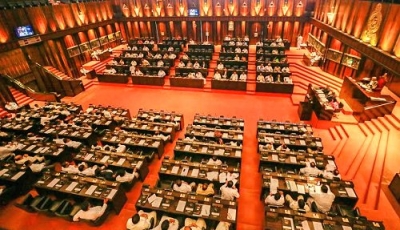Arrival at Parliament: Members of Parliament should arrive at Parliament by 9.00 a.m. the latest. Members who accompany their spouses will alight at the Staff Entrance. All other Members will alight at the Members’ Entrance. To facilitate arrival, Members are kindly requested to have the attached Car Label pasted on the inside top left-hand corner of the windscreen of their cars.
On arrival at Parliament, Members’ cars will be directed by the Police to the appropriate Car Park.
Procedure: Members of Parliament will enter the Lobbies of Parliament and will remain in the Lobbies, till the Quorum Bells are rung.
Proceedings of the Parliament will commence by the Quorum Bells being rung for five minutes from 9.25 a.m. when Members will assemble in the Chamber. At 9.30 a.m., ringing of the Bells will be stopped and the Serjeant-at-Arms will enter the Chamber bearing the Mace. Members will rise in their places until the Serjeant-at-Arms proceeds to the Table and places the Mace on the lower rest of the Table. After the Serjeant-at-Arms has taken his seat, the Secretary-General of Parliament will read the Proclamations made by His Excellency the President summoning the Meeting and proceed immediately to the election of Speaker.
The procedure for election a Speaker is set out in Standing Orders Nos. 3 and 4. A Member desiring to propose a name will stand in his place, and the Secretary-General of Parliament pointing to him, will make his proposal in the form prescribed in Standing Order No. 4(2). If more than one Member stands in his place to make a proposal, the Secretary-General of Parliament will decide the Member to be called first, and on his pointing to that Member, the other Members will remain in their seats until the proposal has been made and seconded. It is usual, and greatly facilitates the proceedings, for Members intending to propose candidates for the office of Speaker to notify their intention to the Secretary-General of Parliament before the meeting begins.
When the Speaker has been elected, he will submit himself to the will of the Parliament and will be led to the Speaker’s Chair by his proposer and seconder. Having reached the Chair the Speaker will, before sitting down, very briefly thank the Parliament for his election. On taking his seat, the Serjeant-at-Arms will take the Mace from the lower rest and place it on the Table. Thereafter, the Speaker will have the Oath or Affirmation administered to him by the Secretary-General of Parliament and sign the Roll of Members. At this stage the Leaders of Parties will congratulate the Speaker on his election to the Chair and the Speaker will again thank the Parliament.
The Speaker will now remind Members that their first duty is to take the Oath or make the Affirmation required by law. He will then proceed to have the Oath or Affirmation administered to Members. Oath papers will now be distributed to Members who after taking the Oath or making the Affirmation will sign the Roll of Members and hand over the perfected and signed Oath papers to the Secretary-General of Parliament.
After the Oath or Affirmation has been administered to all Members present, the Parliament will proceed to the election of a Deputy Speaker and a Deputy Chairman of Committees in nearly the same manner as the election of the Speaker, except that the election will be conducted by the Speaker himself (Vide Standing Order No. 6).
His Excellency the President will address Parliament in terms of Article 32(4) and 33 of the Constitution.
Thereafter the Parliament will be adjourned.
Eighth Parliament's first sitting will commence tomorrow














